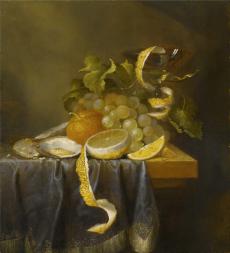


A still life is represented consisting of three oysters, an orange, a lemon in sections, a bunch of grapes with its vine leaves and a tall façon-de-Venise wine glass, with a lemon peel decoratively curled around it. A bit of white wine is in the glass, and the lemon peel is used to impart extra flavour to the wine. A few drops of lemon juice were used, much like today, to give the oysters some acidity and taste. Parts of these objects are placed on a blue-grey cloth with long white tassels and a decorated fringe. This work is interesting from a colouristic point of view, with its pretty, light and pleasant palette. The paint of the skins of the orange and the pieces of lemon was thickly applied, and the ribbed peel of the fruit is therefore captured very well. The work does not have a signature. It was acquired as a work by Cornelis Kruys (c. 1619-1654); the still lifes of this Haarlem artist were always heavily influenced by the work of his fellow townsman, Pieter Claesz. (c.1597- 1661), the most important painter in this genre in Holland between 1620 and 1640. However, the A. G. Leventis Collection still life was not inspired by the work of Pieter Claesz. In fact, in style and composition, it is closely connected with the still lifes of the 1640s by Jan Davidsz. de Heem (1606- 1683/4). At that time, de Heem became without doubt the most influential painter of still lifes both in the Northern and Southern Netherlands. He had many pupils and followers. Although this work is painted in his style, de Heem’s brush never touched this panel. Its style is, however, distinct, and it is therefore possible to discover the hand of an able master. On the basis of the colour scheme, and especially the way in which the folds of the cloth are represented falling over the table ledge, it is possible to attribute this still life to Laurens Craen.
Characteristic for Craen’s work is his use of oblique lighting that is at the same time clear and soft, yet plastic; also his tonality is very much in evidence here, especially in the light clear green and the transitions from yellow to orange. As we see here, his compositions often include vine foliage with wavy leaves and tendrils rendered calligraphically; the accumulation of objects on the ledge is frequently crowned by a large façon-de-Venise glass with a lemon peel curled around it. Moreover, any doubt about the attribution to Laurens Craen can be dismissed when we take a closer look at the drapery on the table. This piece of textile must have been a prop in Craen’s studio, as this cloth with its long tassels and decorative, embroidered fringe appears in a number of paintings. We see it, among other examples, in two still lifes with fruit and a lobster and a Still Life with Fruits on a Wooden Table Ledge, which is signed and dated 1649 by the artist. This date makes it clear that the work in the A. G. Leventis Collection can be dated c. 1650.
Not much research into the life and oeuvre of Laurens Craen has been undertaken. It is remarkable that only about two dozen paintings are presently known by this talented master, all of them still lifes – he does not seem to have painted anything else. Laurens was possibly the son of Pieter Craen, an artist who is mentioned in the guild records of The Hague in 1623-1624 as a pupil of the important portrait painter Jan Anthonisz. van Ravesteyn (c. 1572-1657). As far as we know, Laurens lived and worked in Middelburg in the Province of Zeeland between 1649 and 1666. We know that he sent a letter, dated 14 October 1649, to Constantijn Huygens, secretary to the Prince of Orange, in which he offered his services to the court.6 It is possible that Craen worked with de Heem in Antwerp around 1645-1646, before settling in Middelburg.
Not much is known about this Dutch painter. He may have worked briefly with Jan Davidsz. de Heem and helived in Middelburg between 1649 and c. 1666. About two dozen paintings by him are known, all of them stilllifes with fruit and other foods, characterised by his use of oblique lighting and refined tonality.